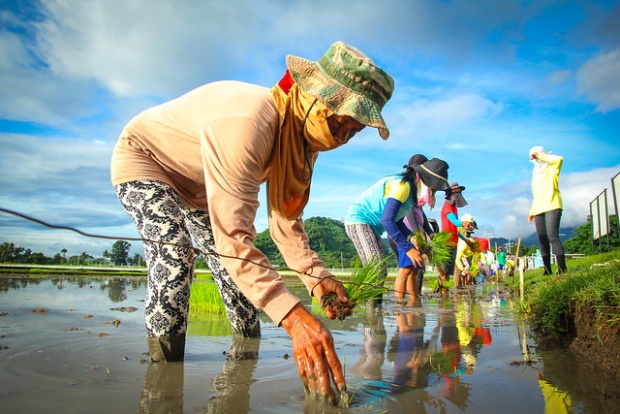 Farmers can benefit from climate-resilient technologies and practices that address location-specific concerns on their farms. Photo: IRRI
Farmers can benefit from climate-resilient technologies and practices that address location-specific concerns on their farms. Photo: IRRI
Amidst the era of a changing climate, the Philippines must identify initiatives that can improve the productivity of its farmers and support its adaptation and mitigation actions.
Experts on climate change, agriculture and other relevant fields in the Philippines came together to identify climate-resilient agriculture (CRA) technologies and practices that farmers can adopt into their fields. These CRA interventions were selected based on their relevance to the different agro-ecological systems in the Philippines. The technologies and practices were ranked to determine those that the country can prioritize for implementation. The key criterion for prioritization was the intervention’s potential to improve agricultural productivity, increase climate resilience, and reduce greenhouse gas emissions.
Altogether, the information will be brought together in a book titled “Compendium of Climate-resilient Agriculture Technologies and Practices in the Philippines.” It will be published by the CGIAR Research Program on Climate Change, Agriculture and Food Security in Southeast Asia (CCAFS SEA) and will be distributed to various audience groups such as policymakers, agricultural extension workers and farmers. The book may serve as a valuable reference for climate action in the Philippines, especially for its Adaptation and Mitigation Initiative in Agriculture.
Multi-sectoral; participatory
CCAFS SEA invited participants from the academia, government offices and international research organizations to consult them for advice on the draft of the book. They were instructed to assess the initial list of technologies and practices based on a prioritization scheme.
Dr. Leocadio Sebastian, Regional Program Leader for CCAFS SEA, told them they could suggest further initiatives that they thought possessed CRA potential. Dr. Romeo Labios, one of the principal authors of the book, reminded them to provide CCAFS SEA with papers to include their suggestions in the draft. Likewise, they could omit any technology or practice that did not contain an adaptation or mitigation component.
The discussions included a critical evaluation of the assessment methods and groupings of the CRA interventions. For instance, several participants shared that they modified indicators to properly assess the interventions. In terms of the groupings, they advised adding more categories since several practices followed the same principles. The proposed categories included agroforestry, crop diversification, and soil and water conservation measures.
Aside from CRA interventions, the participants also assessed web-based applications on agriculture. These included the Rice Crop Manager, Smarter Pest Identification Technology, the Individual Tangible Response to Ecosystem Enhancement, Water Management Decision Support System and the Smarter Agriculture Enhanced Agricultural Monitoring System. The participants lauded the integration of web technologies in climate actions. Still, they stressed that web developers must look for crop suitability assessments, maps and other sources in developing agriculture-based applications.
Agricultural transformation
Dr. Sebastian added that the Philippines must transform its agriculture sector to thrive under climate change conditions. The need for an agricultural transformation arises from the complexities of climate change, which traverses the environmental, economic, and socio-political landscapes. The steps he mentioned were grouped into actions and strategies.
The actions, on one hand, refer to the steps that the country must take to achieve agricultural transformation. These include:
- Evaluating suitability of technologies and practices;
- providing relevant climate information services;
- mapping out of climate risk and crop suitability;
- implementing low-emission initiatives;
- mechanizing the farms;
- diversifying crops and livelihoods;
- improving access to credit and insurance;
- promoting entrepreneurship to farmers;
- engaging the private sector;
- building climate-proof infrastructures; and
- training the youth in agri-entrepreneurship.
The strategies, on the other hand, present how these actions can be implemented in the Philippines. The strategies include:
- adopting integrated landscape approaches;
- empowering farmers and farmer organizations;
- digitalizing the agriculture sector;
- mainstreaming low-emission development;
- improving access to financial platforms;
- enhancing social inclusion; and
- educating consumers and producers.
The technologies and practices were discussed during a stakeholder consultation workshop organized by CCAFS SEA 31 January–1 February 2019 at the Southeast Asian Regional Center for Graduate Study and Research in Agriculture (SEARCA). The participants came from the World Agroforestry Centre (ICRAF) Philippines, the International Rice Research Institute (IRRI), the International Institute of Rural Reconstruction (IIRR), SEARCA, the University of the Philippines Los Baños (UPLB), the University of the Philippines Visayas (UPV), the Department of Environment and Natural Resources (DENR) and the Department of Agriculture (DA).













